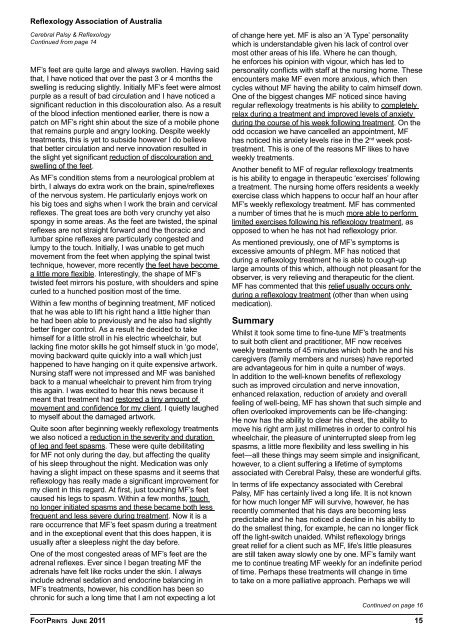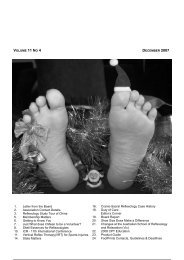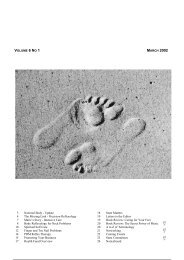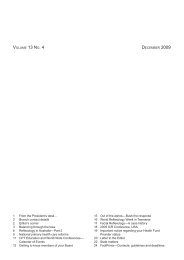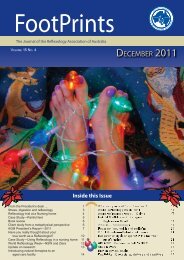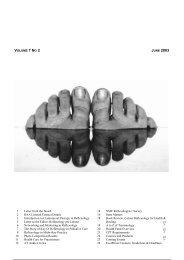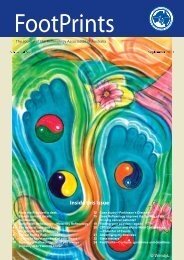FootPrints_June_11_Vol_15_No2.pdf 3137KB Apr 26 2013 03:57 ...
FootPrints_June_11_Vol_15_No2.pdf 3137KB Apr 26 2013 03:57 ...
FootPrints_June_11_Vol_15_No2.pdf 3137KB Apr 26 2013 03:57 ...
You also want an ePaper? Increase the reach of your titles
YUMPU automatically turns print PDFs into web optimized ePapers that Google loves.
Reflexology Association of Australia<br />
Cerebral Palsy & Reflexology<br />
Continued from page 14<br />
MF’s feet are quite large and always swollen. Having said<br />
that, I have noticed that over the past 3 or 4 months the<br />
swelling is reducing slightly. Initially MF’s feet were almost<br />
purple as a result of bad circulation and I have noticed a<br />
significant reduction in this discolouration also. As a result<br />
of the blood infection mentioned earlier, there is now a<br />
patch on MF’s right shin about the size of a mobile phone<br />
that remains purple and angry looking. Despite weekly<br />
treatments, this is yet to subside however I do believe<br />
that better circulation and nerve innovation resulted in<br />
the slight yet significant reduction of discolouration and<br />
swelling of the feet.<br />
As MF’s condition stems from a neurological problem at<br />
birth, I always do extra work on the brain, spine/reflexes<br />
of the nervous system. He particularly enjoys work on<br />
his big toes and sighs when I work the brain and cervical<br />
reflexes. The great toes are both very crunchy yet also<br />
spongy in some areas. As the feet are twisted, the spinal<br />
reflexes are not straight forward and the thoracic and<br />
lumbar spine reflexes are particularly congested and<br />
lumpy to the touch. Initially, I was unable to get much<br />
movement from the feet when applying the spinal twist<br />
technique, however, more recently the feet have become<br />
a little more flexible. Interestingly, the shape of MF’s<br />
twisted feet mirrors his posture, with shoulders and spine<br />
curled to a hunched position most of the time.<br />
Within a few months of beginning treatment, MF noticed<br />
that he was able to lift his right hand a little higher than<br />
he had been able to previously and he also had slightly<br />
better finger control. As a result he decided to take<br />
himself for a little stroll in his electric wheelchair, but<br />
lacking fine motor skills he got himself stuck in ‘go mode’,<br />
moving backward quite quickly into a wall which just<br />
happened to have hanging on it quite expensive artwork.<br />
Nursing staff were not impressed and MF was banished<br />
back to a manual wheelchair to prevent him from trying<br />
this again. I was excited to hear this news because it<br />
meant that treatment had restored a tiny amount of<br />
movement and confidence for my client. I quietly laughed<br />
to myself about the damaged artwork.<br />
Quite soon after beginning weekly reflexology treatments<br />
we also noticed a reduction in the severity and duration<br />
of leg and feet spasms. These were quite debilitating<br />
for MF not only during the day, but affecting the quality<br />
of his sleep throughout the night. Medication was only<br />
having a slight impact on these spasms and it seems that<br />
reflexology has really made a significant improvement for<br />
my client in this regard. At first, just touching MF’s feet<br />
caused his legs to spasm. Within a few months, touch<br />
no longer initiated spasms and these became both less<br />
frequent and less severe during treatment. Now it is a<br />
rare occurrence that MF’s feet spasm during a treatment<br />
and in the exceptional event that this does happen, it is<br />
usually after a sleepless night the day before.<br />
One of the most congested areas of MF’s feet are the<br />
adrenal reflexes. Ever since I began treating MF the<br />
adrenals have felt like rocks under the skin. I always<br />
include adrenal sedation and endocrine balancing in<br />
MF’s treatments, however, his condition has been so<br />
chronic for such a long time that I am not expecting a lot<br />
of change here yet. MF is also an ‘A Type’ personality<br />
which is understandable given his lack of control over<br />
most other areas of his life. Where he can though,<br />
he enforces his opinion with vigour, which has led to<br />
personality conflicts with staff at the nursing home. These<br />
encounters make MF even more anxious, which then<br />
cycles without MF having the ability to calm himself down.<br />
One of the biggest changes MF noticed since having<br />
regular reflexology treatments is his ability to completely<br />
relax during a treatment and improved levels of anxiety<br />
during the course of his week following treatment. On the<br />
odd occasion we have cancelled an appointment, MF<br />
has noticed his anxiety levels rise in the 2 nd week posttreatment.<br />
This is one of the reasons MF likes to have<br />
weekly treatments.<br />
Another benefit to MF of regular reflexology treatments<br />
is his ability to engage in therapeutic ‘exercises’ following<br />
a treatment. The nursing home offers residents a weekly<br />
exercise class which happens to occur half an hour after<br />
MF’s weekly reflexology treatment. MF has commented<br />
a number of times that he is much more able to perform<br />
limited exercises following his reflexology treatment, as<br />
opposed to when he has not had reflexology prior.<br />
As mentioned previously, one of MF’s symptoms is<br />
excessive amounts of phlegm. MF has noticed that<br />
during a reflexology treatment he is able to cough-up<br />
large amounts of this which, although not pleasant for the<br />
observer, is very relieving and therapeutic for the client.<br />
MF has commented that this relief usually occurs only<br />
during a reflexology treatment (other than when using<br />
medication).<br />
Summary<br />
Whilst it took some time to fine-tune MF’s treatments<br />
to suit both client and practitioner, MF now receives<br />
weekly treatments of 45 minutes which both he and his<br />
caregivers (family members and nurses) have reported<br />
are advantageous for him in quite a number of ways.<br />
In addition to the well-known benefits of reflexology<br />
such as improved circulation and nerve innovation,<br />
enhanced relaxation, reduction of anxiety and overall<br />
feeling of well-being, MF has shown that such simple and<br />
often overlooked improvements can be life-changing:<br />
He now has the ability to clear his chest, the ability to<br />
move his right arm just millimetres in order to control his<br />
wheelchair, the pleasure of uninterrupted sleep from leg<br />
spasms, a little more flexibility and less swelling in his<br />
feet—all these things may seem simple and insignificant,<br />
however, to a client suffering a lifetime of symptoms<br />
associated with Cerebral Palsy, these are wonderful gifts.<br />
In terms of life expectancy associated with Cerebral<br />
Palsy, MF has certainly lived a long life. It is not known<br />
for how much longer MF will survive, however, he has<br />
recently commented that his days are becoming less<br />
predictable and he has noticed a decline in his ability to<br />
do the smallest thing, for example, he can no longer flick<br />
off the light-switch unaided. Whilst reflexology brings<br />
great relief for a client such as MF, life’s little pleasures<br />
are still taken away slowly one by one. MF’s family want<br />
me to continue treating MF weekly for an indefinite period<br />
of time. Perhaps these treatments will change in time<br />
to take on a more palliative approach. Perhaps we will<br />
Continued on page 16<br />
FOOTPRINTS JUNE 20<strong>11</strong> <strong>15</strong>


